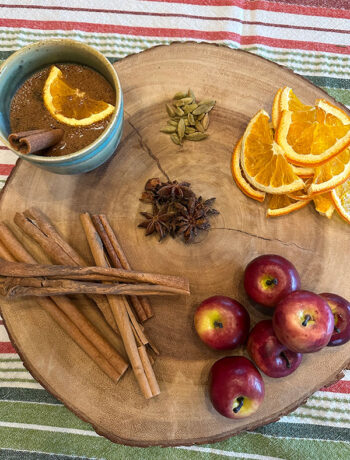Fall is just around the corner. That means cool weather preserving with tomatoes and Fall fruits. This week, I harvested some rhubarb (the vegetable that keeps on giving) and combined it with apples for a truly Fall inspired chutney with dried cranberries. Nothing says transition more than combining spring and Fall fruits!
As I prepared the apples for the chutney, I treated them to prevent oxidization. That reminded me of a woman in the grocery store who was asking whether citric acid could be used as a substitute for ascorbic acid. I thought it might be useful to explore that question.
There are two reasons to use acids: First to prevent browning or oxidation. And second to acidify foods that are not naturally acidic enough to be safely preserved.
Oxidation is a naturally occurring phenomenon that happens when pale fruits and vegetables are exposed to oxygen. Apples, pears, peaches, and some vegetables will turn a brownish colour in the presence of air. Treating them with acid prevents this from happening.
Ascorbic Acid (Vitamin C)
Six crushed Vitamin C tablets in 2 litres of water will do the trick to prevent browning. The tablets are easily available in pharmacies. A 10-minute dunk in the acid/water bath will help hold the colour of fruit as you prepare the recipe.
Citric Acid can also be used to prevent oxidation with cut fruit or as a pre-treatment for frozen or dried fruit. Alternatively, using lemon juice in a solution of ¼ cup lemon juice to 2 litres of water will provide an effective solution for prevent oxidation. Many people choose to use Fruit Fresh, a commercial anti-browning agent that contains citric and ascorbic acids and silicon dioxide. I like lemon juice as it contains both ascorbic and citric acid and it’s natural!
Citric vs Ascorbic Acid
The question is whether these two acids can be used interchangeably? The answer is NO. While citric acid can be used as an anti-browning agent, it is mostly used to lower pH in foods as it is far more acidic than ascorbic acid. For example, tomatoes, which hover around the 4.6 pH level need to be acidified for safe canning. Citric acid or lemon juice are effective for this purpose. Ascorbic acid is a strong antioxidant and preserver of colour but is not used alone to acidify foods. As always, use authoritative recipes that will recommend the type and amount of acid to prevent oxidation or to properly acidify food.
Transitioning to Fall brings a whole new life to the preserving kitchen. Aromas of spice, mixed with fruit, tomato bubbling with vegetables for chili sauce. It feels like a new season is upon us.
preservingwithmartha@gmail.com
Apple-Rhubarb Chutney (adapted from Bernardin)
Ingredients
- 4 cups diced peeled and cored apples treated to prevent oxidation. I used Sunrise Apples and Granny Smith.
- 2 cup chopped rhubarb
- ½ cup water
- Zest and juice of one lemon.
- ½ cup dried cranberries or use raisins, currants, dried cherries, or blueberries
- 1 tsp cinnamon
- ½ tsp each nutmeg and ground allspice
Instructions
After draining apples, combine with rhubarb, sugar, water and lemon juice and zest. Boil gently for 15 minutes. Add dried fruit and spices. Continue gently boiling for another 15 minutes until the chutney thickens. Ladle into 4 250ml hot jars leaving a ½ inch headspace. Remove bubbles and adjust headspace. Clean rims and affix lids and rings to finger-tip tight. Process in a water-bath or steam canner for 10 minutes adjusting for altitude. Allow jars to rest for 5 minutes before removing to a heat-proof surface.






No Comments